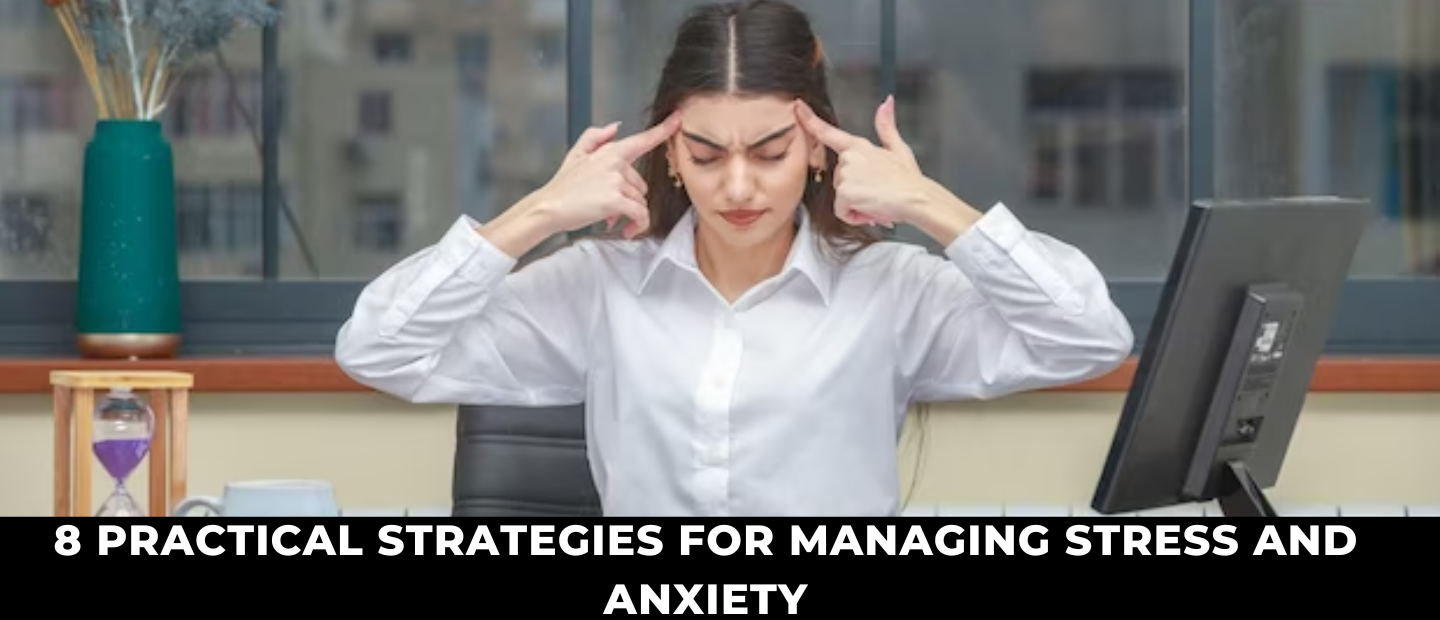In today’s fast-paced and demanding world, stress and anxiety have become prevalent issues that affect many people. While it’s normal to experience occasional stress, chronic stress and anxiety can have detrimental effects on our mental and physical health. Fortunately, there are practical strategies we can implement to effectively manage and reduce stress and anxiety at home or at workplace. In this blog post, we will explore eight practical and evidence-based techniques that can help you navigate these challenges and lead a more balanced and peaceful life.
1. Practice Deep Breathing and Mindful Meditation
Techniques for focused meditation and deep breathing are effective ways to manage stress and anxiety at home or at workplace. The body’s relaxation response is triggered by deep, steady breathing, which lowers the stress hormone cortisol. Find a calm, cosy area, close your eyes, and concentrate on your breathing. Take a few deep breaths through your nose, hold them for a moment, and then gently let them out through your lips. Combine deep breathing with focused observation of your thoughts and emotions during meditation. These methods can help to create calm and regain mental equilibrium when they are regularly practised.
2. Engage in Regular Physical Activity
Exercise is essential for controlling stress and anxiety in addition to being good for physical health. Regular exercise results in endorphin release, which naturally elevates mood. Find an activity you love doing, whether it’s yoga, dancing, swimming, or jogging. Try to exercise for at least 30 minutes, most days of the week, at a moderate level. You may lower stress, get better sleep, and generally feel better by including exercise into your daily routine.
3. Adopt Healthy Lifestyle Habits
Maintaining a healthy lifestyle can significantly impact your ability to manage stress and anxiety. Ensure you get adequate sleep, eat a balanced diet, and limit caffeine and alcohol intake. Sleep deprivation and poor nutrition can exacerbate stress and anxiety symptoms. Additionally, prioritize self-care activities that promote relaxation and rejuvenation, such as taking warm baths, reading, or listening to calming music. By taking care of your physical well-being, you provide a solid foundation for managing stress and anxiety effectively at home and at workplace also.

4. Practice Time Management and Prioritization
A lengthy to-do list might make you feel overwhelmed, which can increase your stress levels. Setting realistic objectives and prioritising chores will help you develop efficient time management skills. Divide more difficult activities into smaller, more doable segments. To manage and organise your obligations, use digital applications, planners, and calendars. You may lower stress and boost productivity by successfully managing your time, giving yourself a sense of control over your everyday life.
5. Cultivate Supportive Relationships
Social support is crucial for managing stress and anxiety. Cultivate relationships with supportive and understanding individuals who can provide a listening ear or offer guidance. Share your feelings and concerns with trusted friends, family members, or seek support from a therapist or counsellor. Connecting with others who can empathize with your experiences can provide comfort and reassurance during challenging times. Remember, you don’t have to face stress and anxiety alone.
6. Practice Relaxation Techniques
Use relaxation methods as part of your everyday practise to properly handle stress and anxiety. To relieve tension, try progressive muscle relaxation, in which you gradually tense and relax various muscle groups. Take part in leisurely pursuits like nature walks, yoga or tai chi classes, or listening to relaxing music or guided imagery. Find the hobbies that suit you most, and schedule time for them frequently. The use of relaxation techniques can assist to clear the mind, lessen the effects of stress on the body, and foster inner tranquilly.

7. Challenge Negative Thinking Patterns
Stress and anxiety often stem from negative thinking patterns and excessive worry. Practice cognitive restructuring, which involves identifying and challenging negative thoughts. Replace irrational or negative thoughts with more realistic and positive ones. Reframe stressful situations by focusing on potential solutions rather than dwelling on problems. Additionally, practice self-compassion and offer yourself kindness and understanding during challenging times. By changing your mindset and cultivating positive thinking, you can reduce stress and anxiety levels.
8. Seek Professional Help when Needed
If stress and anxiety become overwhelming and interfere with your daily functioning, seeking professional help is crucial. Reach out to a mental health professional, such as a therapist or counsellor, who can provide guidance, support, and evidence-based techniques tailored to your specific needs. Professional assistance can help you develop coping strategies, explore underlying causes of stress and anxiety, and navigate challenging emotions in a safe and supportive environment.
Conclusion
Managing stress and anxiety is a journey that requires patience, self-awareness, and a willingness to implement practical strategies. By incorporating deep breathing, exercise, healthy habits, time management, supportive relationships, relaxation techniques, positive thinking, and professional help, you can develop effective tools to manage stress and anxiety, leading to a more balanced and fulfilling life. Remember, self-care is essential, and you deserve to prioritize your mental well-being.


